Ternary Hybrid Materials for Highly Sensitive Acetone Sensing at Room Temperature
Abstract
:1. Introduction
1.1. Background
1.2. Sensing Mechanism
2. Materials and Methods
2.1. Materials
2.2. Synthesis of Ternary Hybrid Nanocomposite Fe3O4-PANI-RGO
2.3. Thin-Film Development and Gas-Sensing Setup
2.4. Characterization
3. Results and Discussion
3.1. Microstructural Analysis
3.2. Raman Analysis
3.3. Morphological Analysis
3.4. Sensing Analysis
4. Conclusions
Author Contributions
Funding
Data Availability Statement
Acknowledgments
Conflicts of Interest
References
- Zhang, D.; Hu, Y.; Chen, Y.; Zeng, B. BreathTrack: Tracking Indoor Human Breath Status via Commodity WiFi. IEEE Internet Things J. 2019, 6, 3899–3911. [Google Scholar] [CrossRef]
- Zhou, X.; Xue, Z.; Chen, X.; Huang, C.; Bai, W.; Lu, Z.; Wang, T. Nanomaterial-based gas sensors used for breath diagnosis. J. Mater. Chem. B 2020, 8, 3231–3248. [Google Scholar] [CrossRef]
- van Keulen, K.E.; Jansen, M.E.; Schrauwen, R.W.M.; Kolkman, J.J.; Siersema, P.D. Volatile organic compounds in breath can serve as a non-invasive diagnostic biomarker for the detection of advanced adenomas and colorectal cancer. Aliment Pharm. 2020, 51, 334–346. [Google Scholar] [CrossRef]
- Woollam, M.; Siegel, A.P.; Grocki, P.; Saunders, J.L.; Sanders, D.B.; Agarwal, M.; Davis, M.D. Preliminary method for profiling volatile organic compounds in breath that correlate with pulmonary function and other clinical traits of subjects diagnosed with cystic fibrosis: A pilot study. J. Breath Res. 2022, 16, 027103. [Google Scholar] [CrossRef]
- Khan, R.M.M.; Chua, Z.J.Y.; Tan, J.C.; Yang, Y.; Liao, Z.; Zhao, Y. From Pre-Diabetes to Diabetes: Diagnosis, Treatments and Translational Research. Medicina 2019, 55, 546. [Google Scholar] [CrossRef]
- Dixit, K.; Fardindoost, S.; Ravishankara, A.; Tasnim, N.; Hoorfar, M. Exhaled Breath Analysis for Diabetes Diagnosis and Monitoring: Relevance, Challenges and Possibilities. Biosensors 2021, 11, 476. [Google Scholar] [CrossRef]
- Zhang, H.; Xiao, J.; Wang, Y.; Zhang, L.; Zhao, G.; Yang, H.; Wang, H. A portable acetone detector based on SmFeO3 can pre-diagnose diabetes through breath analysis. J. Alloys Compd. 2022, 922, 166160. [Google Scholar] [CrossRef]
- Baharuddin, A.A.; Ang, B.C.; Haseeb, A.S.M.A.; Wong, Y.C.; Wong, Y.H. Advances in chemiresistive sensors for acetone gas detection. Mater. Sci. Semicon Proc. 2019, 103, 104616. [Google Scholar] [CrossRef]
- Sharma, B.; Sharma, A.; Kim, J.-S. Recent advances on H2 sensor technologies based on MOX and FET devices: A review. Sens. Actuators B Chem. 2018, 262, 758–770. [Google Scholar] [CrossRef]
- Adnan, M.M.; Dalod, A.R.M.; Balci, M.H.; Glaum, J.; Einarsrud, M.A. In Situ Synthesis of Hybrid Inorganic(-)Polymer Nanocomposites. Polymers 2018, 10, 1129. [Google Scholar] [CrossRef] [PubMed]
- Broza, Y.Y.; Har-Shai, L.; Jeries, R.; Cancilla, J.C.; Glass-Marmor, L.; Lejbkowicz, I.; Torrecilla, J.S.; Yao, X.; Feng, X.; Narita, A.; et al. Exhaled Breath Markers for Nonimaging and Noninvasive Measures for Detection of Multiple Sclerosis. ACS Chem. Neurosci 2017, 8, 2402–2413. [Google Scholar] [CrossRef]
- Wu, S.; Fu, G.; Lv, W.; Wei, J.; Chen, W.; Yi, H.; Gu, M.; Bai, X.; Zhu, L.; Tan, C.; et al. A Single-Step Hydrothermal Route to 3D Hierarchical Cu2O/CuO/rGO Nanosheets as High-Performance Anode of Lithium-Ion Batteries. Small 2018, 14, 1702667. [Google Scholar] [CrossRef]
- Lu, X.F.; Chen, X.Y.; Zhou, W.; Tong, Y.X.; Li, G.R. alpha-Fe2O3@PANI Core-Shell Nanowire Arrays as Negative Electrodes for Asymmetric Supercapacitors. ACS Appl. Mater. Interfaces 2015, 7, 14843–14850. [Google Scholar] [CrossRef] [PubMed]
- Notarianni, M.; Liu, J.; Vernon, K.; Motta, N. Synthesis and applications of carbon nanomaterials for energy generation and storage. Beilstein J Nanotechnol 2016, 7, 149–196. [Google Scholar] [CrossRef]
- Tabrizi, A.G.; Arsalani, N.; Naghshbandi, Z.; Ghadimi, L.S.; Mohammadi, A. Growth of polyaniline on rGO-Co3S4 nanocomposite for high-performance supercapacitor energy storage. Int. J. Hydrog. Energy 2018, 43, 12200–12210. [Google Scholar] [CrossRef]
- Ahmadi Tabr, F.; Salehiravesh, F.; Adelnia, H.; Gavgani, J.N.; Mahyari, M. High sensitivity ammonia detection using metal nanoparticles decorated on graphene macroporous frameworks/polyaniline hybrid. Talanta 2019, 197, 457–464. [Google Scholar] [CrossRef]
- Bandgar, D.K.; Navale, S.T.; Mane, A.T.; Gupta, S.K.; Aswal, D.K.; Patil, V.B. Ammonia sensing properties of polyaniline/α-Fe2O3 hybrid nanocomposites. Synth. Met. 2015, 204, 1–9. [Google Scholar] [CrossRef]
- Zhao, T.; Ren, Y.; Jia, G.Y.; Zhao, Y.; Fan, Y.; Yang, J.; Zhang, X.; Jiang, W.; Wang, L.; Wei, L. Facile synthesis of mesoporous WO3@graphene aerogel nanocomposites for low-temperature acetone sensing. Chin. Chem. Lett. 2019, 30, 2032–2038. [Google Scholar] [CrossRef]
- Abu Hussein, N.A.; Hawari, H.F.; Wong, Y.H. Synthesis of Iron Oxide/Polyaniline/Reduced Graphene Oxide Nanocomposite Materials as Active Sensing Material. In Proceedings of the 2020 8th International Conference on Intelligent and Advanced Systems (ICIAS), Kuching, Malaysia, 13–15 July 2021. [Google Scholar] [CrossRef]
- Dong, Z.M.; Xia, Q.; Ren, H.; Shang, X.; Lu, X.; Joo, S.W.; Huang, J. Preparation of hollow SnO2/ZnO cubes for the high-performance detection of VOCs. Ceram. Int. 2023, 49, 4650–4658. [Google Scholar] [CrossRef]
- Foronda, J.R.F.; Aryaswara, L.G.; Santos, G.N.C.; Raghu, S.N.V.; Muflikhun, M.A. Broad-class volatile organic compounds (VOCs) detection via polyaniline/zinc oxide (PANI/ZnO) composite materials as gas sensor application. Heliyon 2023, 9, e13544. [Google Scholar] [CrossRef] [PubMed]
- Zhao, H.; Zhang, T.; Qi, R.; Dai, J.; Liu, S.; Fei, T.; Lu, G. Development of solution processible organic-inorganic hybrid materials with core-shell framework for humidity monitoring. Sens. Actuators B Chem. 2018, 255, 2878–2885. [Google Scholar] [CrossRef]
- Liu, Z.; Yang, X.; Huo, L.; Tian, X.; Qi, T.; Yang, F.; Wang, X.; Yu, K.; Ma, F.; Sun, J. P-CuPcTS/n-SnO2 organic-inorganic hybrid film for ppb-level NO2 gas sensing at low operating temperature. Sens. Actuators B Chem. 2017, 248, 324–331. [Google Scholar] [CrossRef]
- Kim, M.Y.; Hwang, J.Y.; Mirzaei, A.; Choi, S.-W.; Kim, S.-I.; Kim, H.-S.; Kim, S.-J.; Roh, J.W.; Choi, M.S.; Lee, K.H.; et al. NO2 Gas Sensing Properties of Ag-Functionalized Porous ZnO Sheets. Adsorpt. Sci. Technol. 2023, 2023, 9021169. [Google Scholar] [CrossRef]
- Andre, R.S.; Mercante, L.A.; Facure, M.H.M.; Mattoso, L.H.C.; Correa, D.S. Enhanced and selective ammonia detection using In2O3/reduced graphene oxide hybrid nanofibers. Appl. Surf. Sci. 2019, 473, 133–140. [Google Scholar] [CrossRef]
- Zhang, B.; Cheng, M.; Liu, G.; Gao, Y.; Zhao, L.; Li, S.; Wang, Y.; Liu, F.; Liang, X.; Zhang, T.; et al. Room temperature NO2 gas sensor based on porous Co3O4 slices/reduced graphene oxide hybrid. Sens. Actuators B Chem. 2018, 263, 387–399. [Google Scholar] [CrossRef]
- Lee, Z.Y.; Hawari, H.F.B.; Djaswadi, G.W.; Kamarudin, K. A Highly Sensitive Room Temperature CO2 Gas Sensor Based on SnO2-rGO Hybrid Composite. Materials 2020, 14, 522. [Google Scholar] [CrossRef]
- Drmosh, Q.A.; Yamani, Z.H.; Hendi, A.H.; Gondal, M.A.; Moqbel, R.A.; Saleh, T.A.; Khan, M.Y. A novel approach to fabricating a ternary rGO/ZnO/Pt system for high-performance hydrogen sensor at low operating temperatures. Appl. Surf. Sci. 2019, 464, 616–626. [Google Scholar] [CrossRef]
- Hussain, N.H.I.; Mustafa, M.K.; Asman, S. Synthesis of PANI/Iron (II, III) Oxide Hybrid Nanocomposites Using SolGel Method. J. Sci. Technol. 2018, 10, 1–4. [Google Scholar] [CrossRef]
- Li, Y.; Zhao, H.; Ban, H.; Yang, M. Composites of Fe2O3 nanosheets with polyaniline: Preparation, gas sensing properties and sensing mechanism. Sens. Actuators B Chem. 2017, 245, 34–43. [Google Scholar] [CrossRef]
- Abokifa, A.A.; Haddad, K.; Fortner, J.; Lo, C.S.; Biswas, P. Sensing mechanism of ethanol and acetone at room temperature by SnO2 nano-columns synthesized by aerosol routes: Theoretical calculations compared to experimental results. J. Mater. Chem. A 2018, 6, 2053–2066. [Google Scholar] [CrossRef]
- Sydulu Singu, B.; Srinivasan, P.; Pabba, S. Benzoyl Peroxide Oxidation Route to Nano Form Polyaniline Salt Containing Dual Dopants for Pseudocapacitor. J. Electrochem. Soc. 2011, 159, A6–A13. [Google Scholar] [CrossRef]
- Amir Faiz, M.S.; Che Azurahanim, C.A.; Raba'ah, S.A.; Ruzniza, M.Z. Low cost and green approach in the reduction of graphene oxide (GO) using palm oil leaves extract for potential in industrial applications. Results Phys. 2020, 16, 102954. [Google Scholar] [CrossRef]
- Manna, R.; Srivastava, S.K. Reduced Graphene Oxide/Fe3O4/Polyaniline Ternary Composites as a Superior Microwave Absorber in the Shielding of Electromagnetic Pollution. ACS Omega 2021, 6, 9164–9175. [Google Scholar] [CrossRef] [PubMed]
- Mathew, J.; Sathishkumar, M.; Kothurkar, N.K.; Senthilkumar, R.; Sabarish Narayanan, B. Polyaniline/Fe3O4-RGO Nanocomposites for Microwave Absorption. IOP Conf. Ser. Mater. Sci. Eng. 2018, 310, 012138. [Google Scholar] [CrossRef]
- Kumar, R.; Youssry, S.M.; Ya, K.Z.; Tan, W.K.; Kawamura, G.; Matsuda, A. Microwave-assisted synthesis of Mn3O4-Fe2O3/Fe3O4@rGO ternary hybrids and electrochemical performance for supercapacitor electrode. Diam. Relat. Mater. 2020, 101, 107622. [Google Scholar] [CrossRef]
- Patil, V.S.; Thoravat, S.S.; Kundale, S.S.; Dongale, T.D.; Patil, P.S.; Jadhav, S.A. Synthesis and testing of polyaniline grafted functional magnetite (Fe3O4) nanoparticles and rGO based nanocomposites for supercapacitor application. Chem. Phys. Lett. 2023, 814, 140334. [Google Scholar] [CrossRef]
- Cai, H.; Feng, C.; Xiao, H.; Cheng, B. Synthesis of Fe3O4/rGO@PANI with three-dimensional flower-like nanostructure and microwave absorption properties. J. Alloys Compd. 2022, 893, 162227. [Google Scholar] [CrossRef]
- Mondal, S.; Rana, U.; Malik, S. Reduced Graphene Oxide/Fe3O4/Polyaniline Nanostructures as Electrode Materials for an All-Solid-State Hybrid Supercapacitor. J. Phys. Chem. C 2017, 121, 7573–7583. [Google Scholar] [CrossRef]
- Ahirrao, D.J.; Pal, A.J.; Singh, V.; Jha, N. Nanostructured porous polyaniline (PANI) coated carbon cloth (CC) as electrodes for flexible supercapacitor device. J. Mater. Sci. Technol. 2021, 88, 168–182. [Google Scholar] [CrossRef]
- Ma, Y.; Zhou, Y.; Sun, Y.; Chen, H.; Xiong, Z.; Li, X.; Shen, L.; Liu, Y. Tunable magnetic properties of Fe3O4/rGO/PANI nanocomposites for enhancing microwave absorption performance. J. Alloys Compd. 2019, 796, 120–130. [Google Scholar] [CrossRef]
- Gupta, M.; Hawari, H.F.; Kumar, P.; Burhanudin, Z.A. Copper Oxide/Functionalized Graphene Hybrid Nanostructures for Room Temperature Gas Sensing Applications. Crystals 2022, 12, 264. [Google Scholar] [CrossRef]
- Zhang, D.Z.; Wu, Z.L.; Zong, X.Q. Metal-organic frameworks-derived zinc oxide nanopolyhedra_S, N_ graphene quantum dots_polyaniline ternary nanohybrid for high-performance acetone sensing. Sens. Actuators B Chem. 2019, 288, 232–242. [Google Scholar] [CrossRef]
- Gupta, M.; Abu Hussein, N.A.; Fahmi Hawari, H. Graphene derivative coated QCM-based gas sensor for volatile organic compound (VOC) detection at room temperature. Indones. J. Electr. Eng. Comput. Sci. 2020, 18, 1279–1286. [Google Scholar] [CrossRef]
- Jiang, T.; Wang, Z.; Li, Z.; Wang, W.; Xu, X.; Liu, X.; Wang, J.; Wang, C. Synergic effect within n-type inorganic–p-type organic nano-hybrids in gas sensors. J. Mater. Chem. C 2013, 1, 3017–3025. [Google Scholar] [CrossRef]
- Yan, Y.; Yang, G.; Xu, J.L.; Zhang, M.; Kuo, C.C.; Wang, S.D. Conducting polymer-inorganic nanocomposite-based gas sensors: A review. Sci. Technol. Adv. Mater. 2021, 21, 768–786. [Google Scholar] [CrossRef]
- Abu Hussein, N.A.; Hawari, H.F.; Wong, Y.H.; Haseeb, A.S.M.A. Preparation and sensing characterization of hybrid iron oxide/polyaniline/reduced graphene oxide at room temperature. Int. J. Chem. Biochem. Sci. 2021, 20, 90–95. [Google Scholar]
- Shafa, M.; Priante, D.; ElAfandy, R.T.; Hedhili, M.N.; Mahmoud, S.T.; Ng, T.K.; Ooi, B.S.; Najar, A. Twofold Porosity and Surface Functionalization Effect on Pt-Porous GaN for High-Performance H2-Gas Sensors at Room Temperature. ACS Omega 2019, 4, 1678–1684. [Google Scholar] [CrossRef]
- Nabeel, M.; Varga, M.; Kuzsella, L.; Fiser, B.; Vanyorek, L.; Viskolcz, B. The Effect of Pore Volume on the Behavior of Polyurethane-Foam-Based Pressure Sensors. Polymers 2022, 14, 3652. [Google Scholar] [CrossRef]

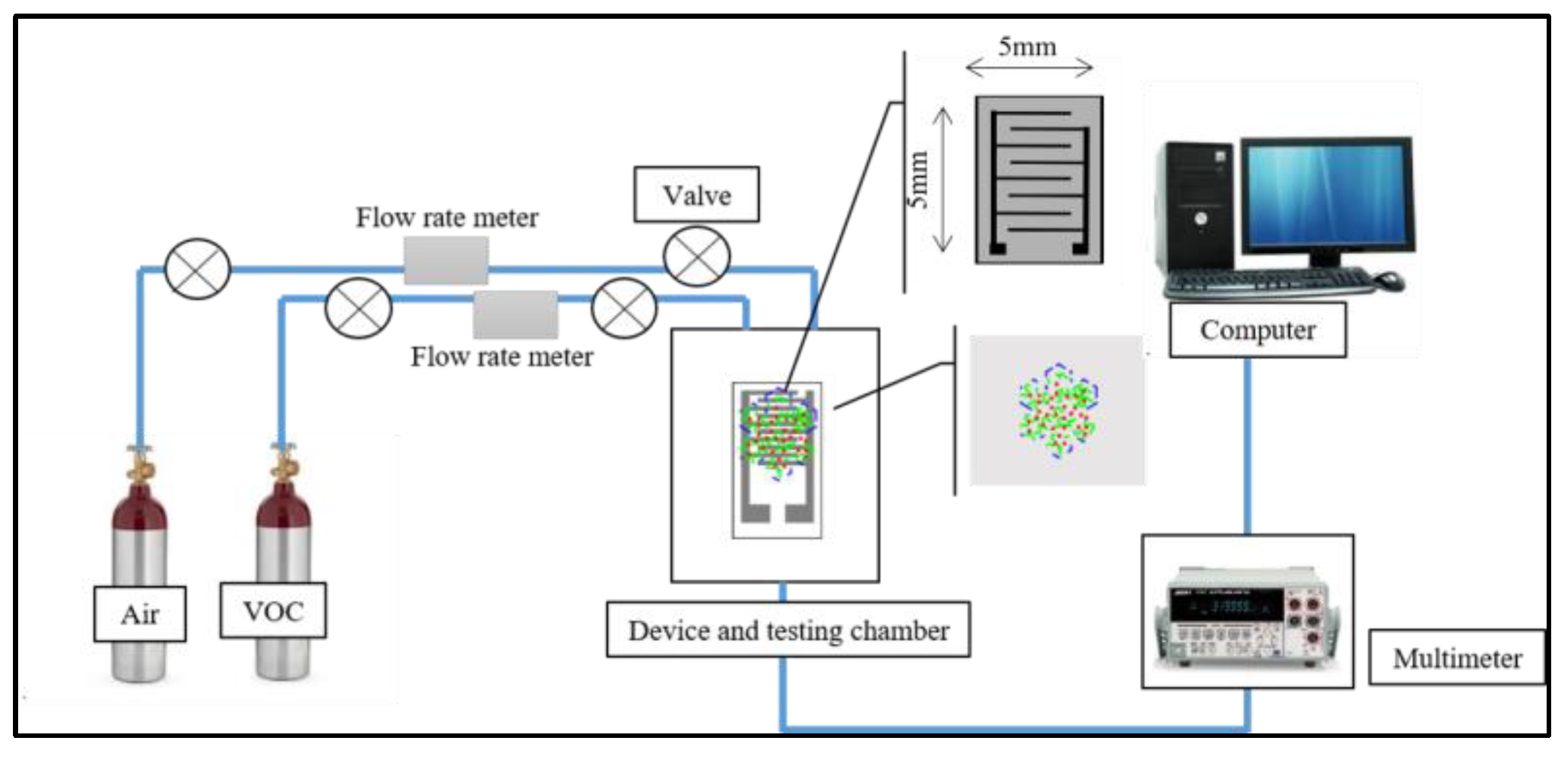

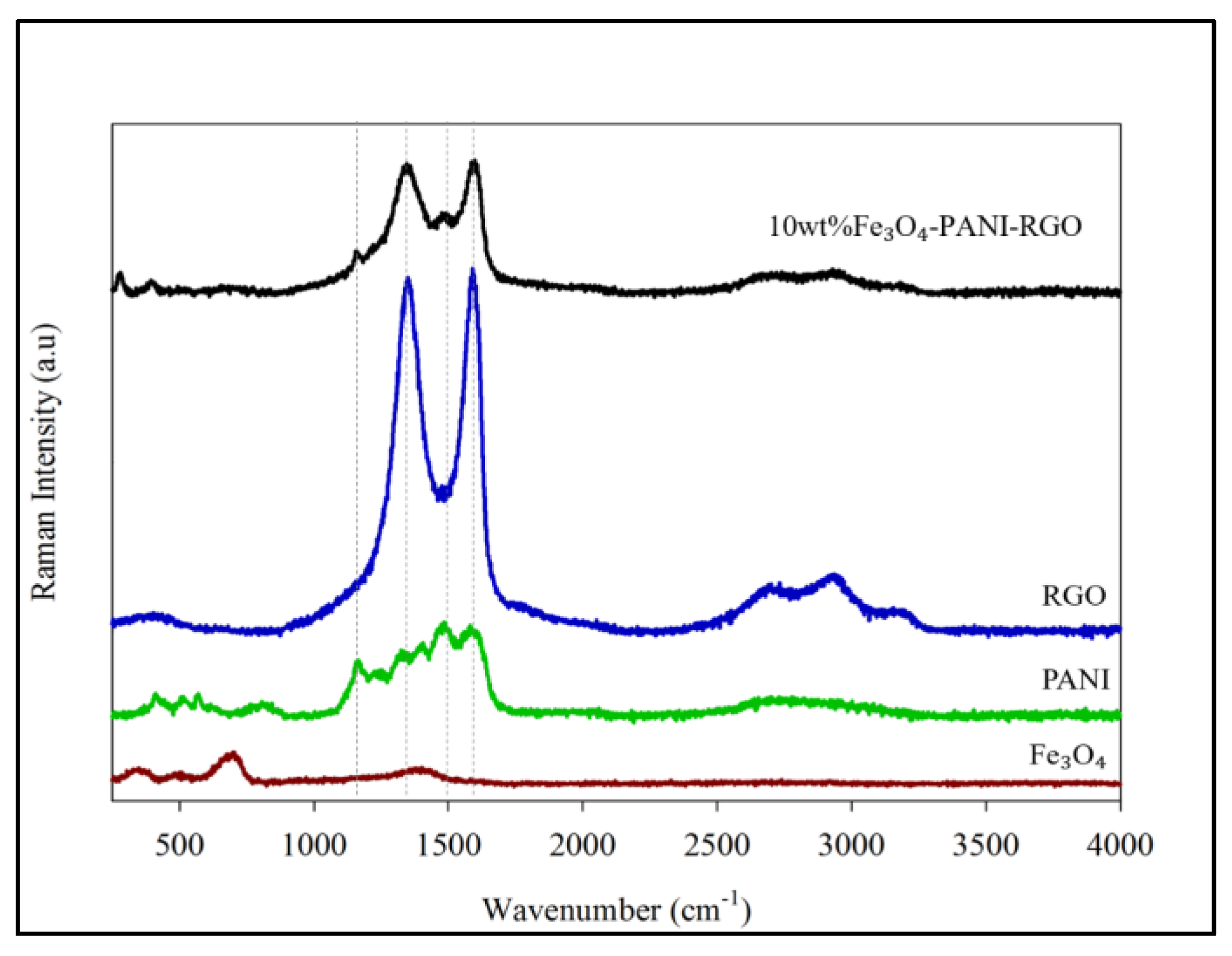
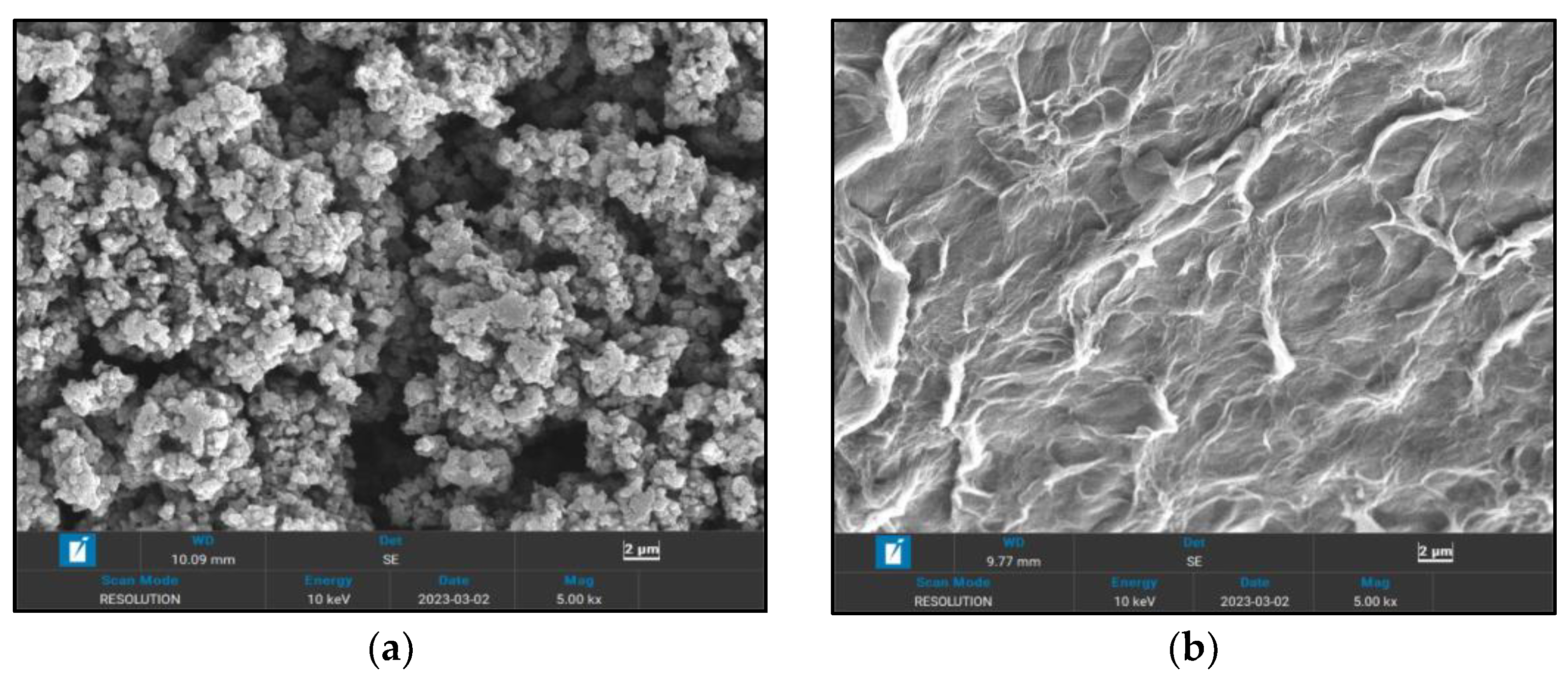

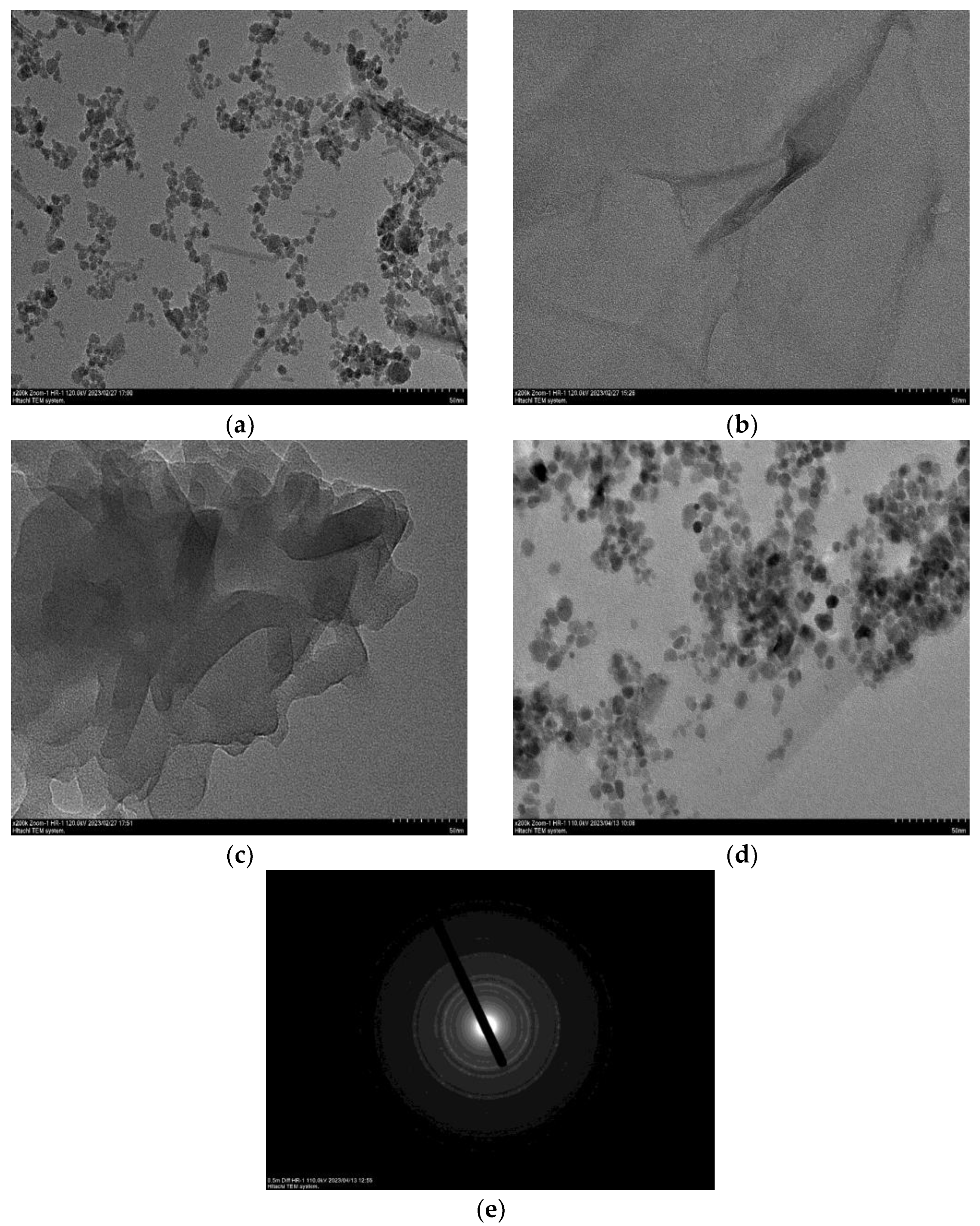

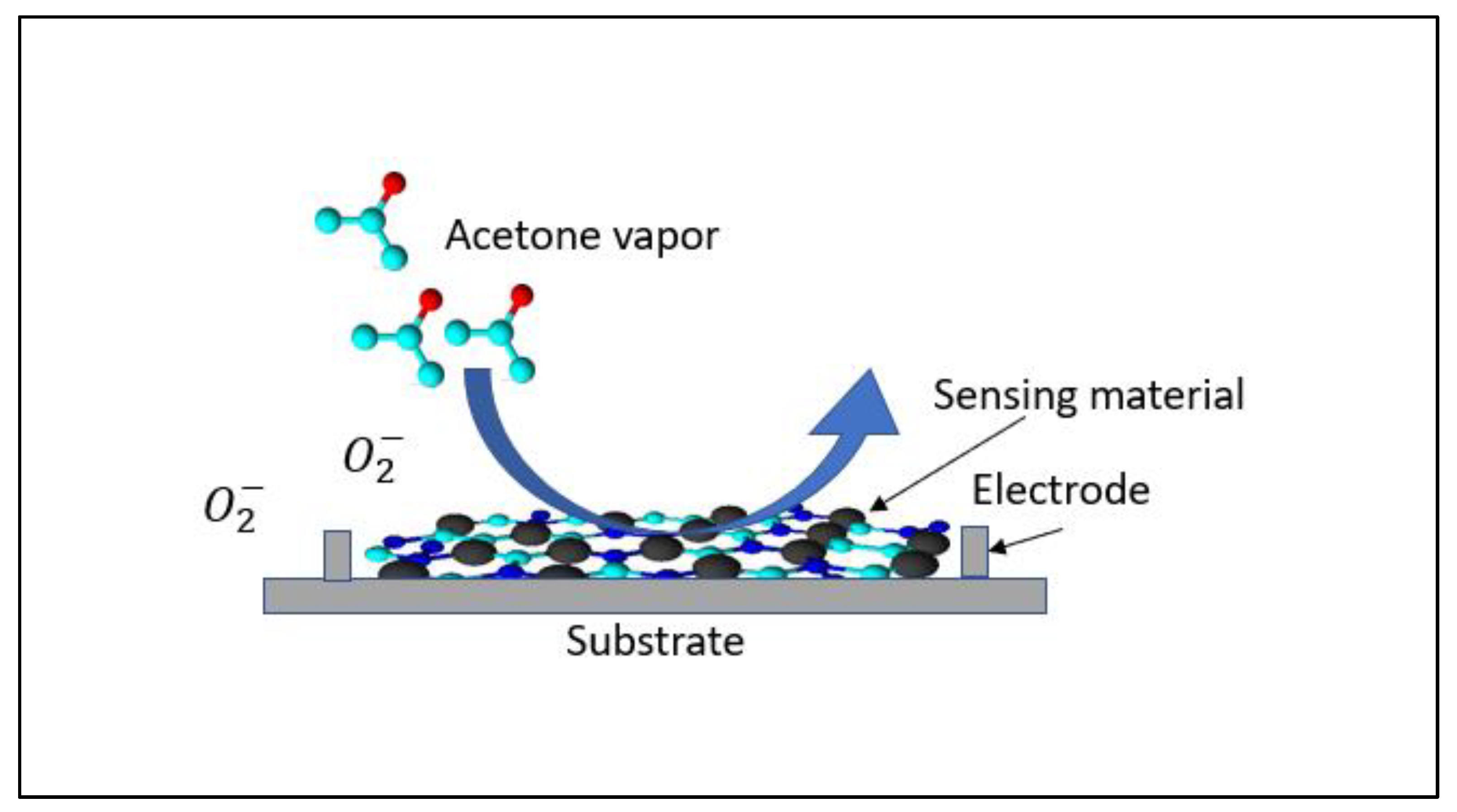

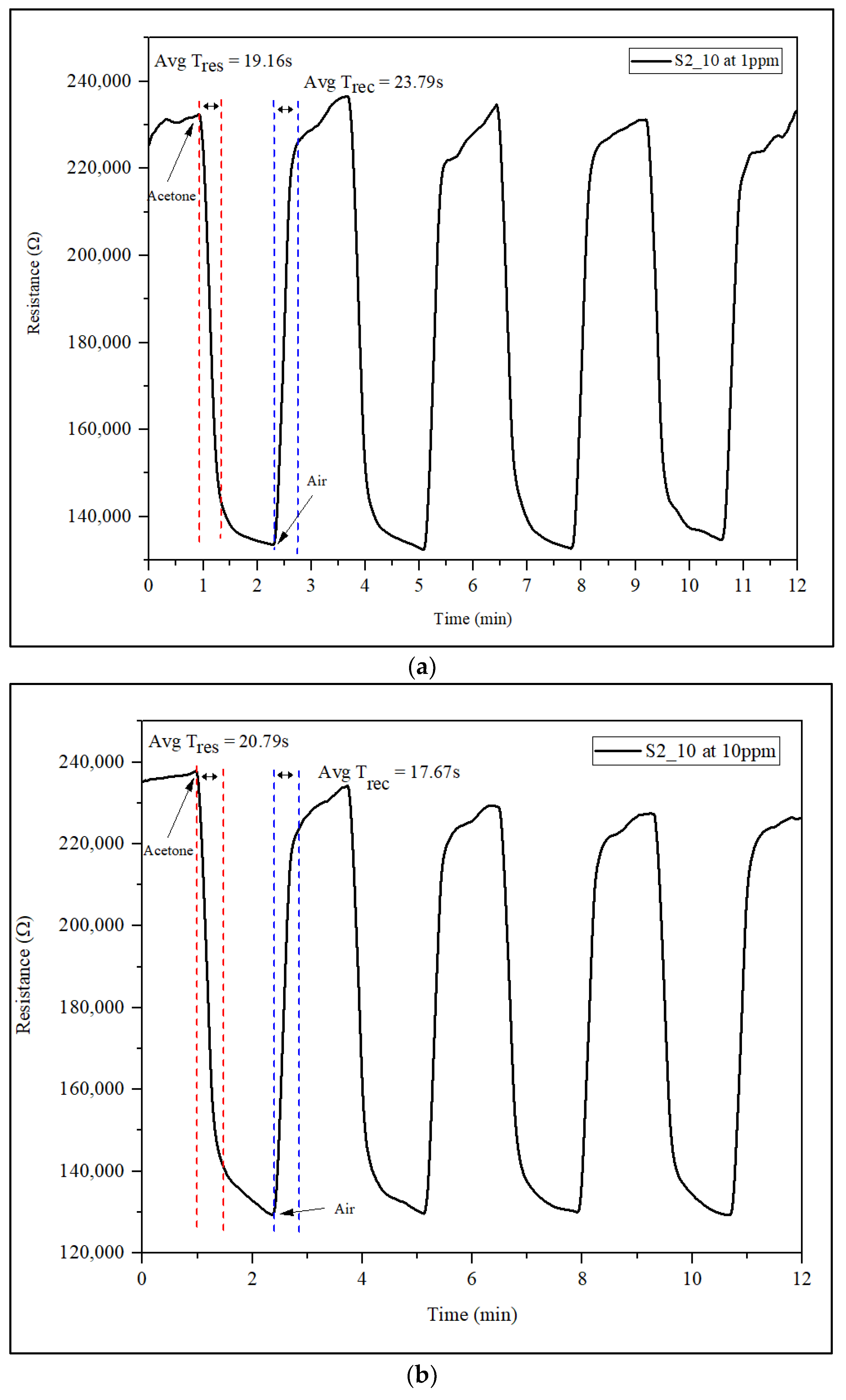

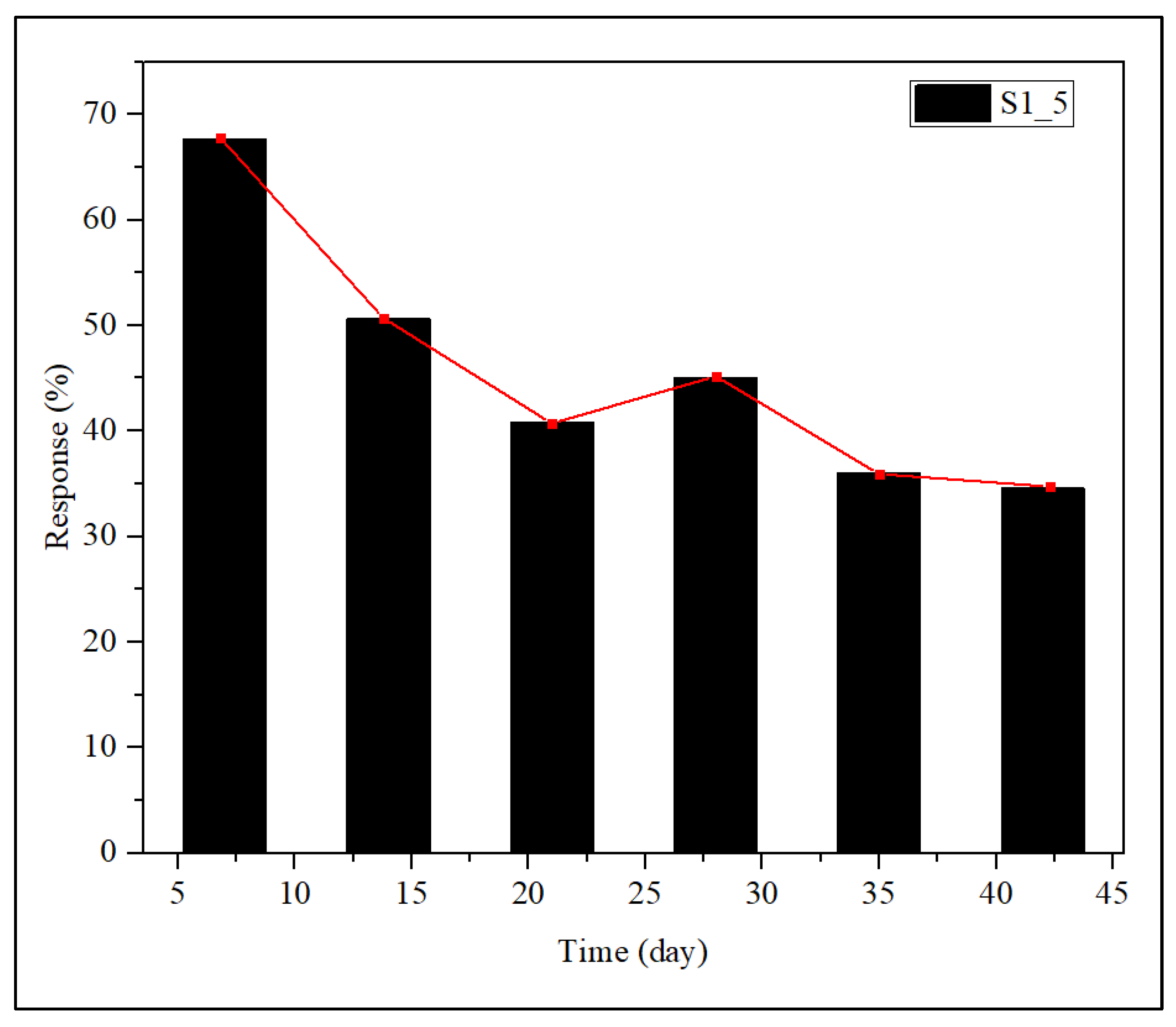
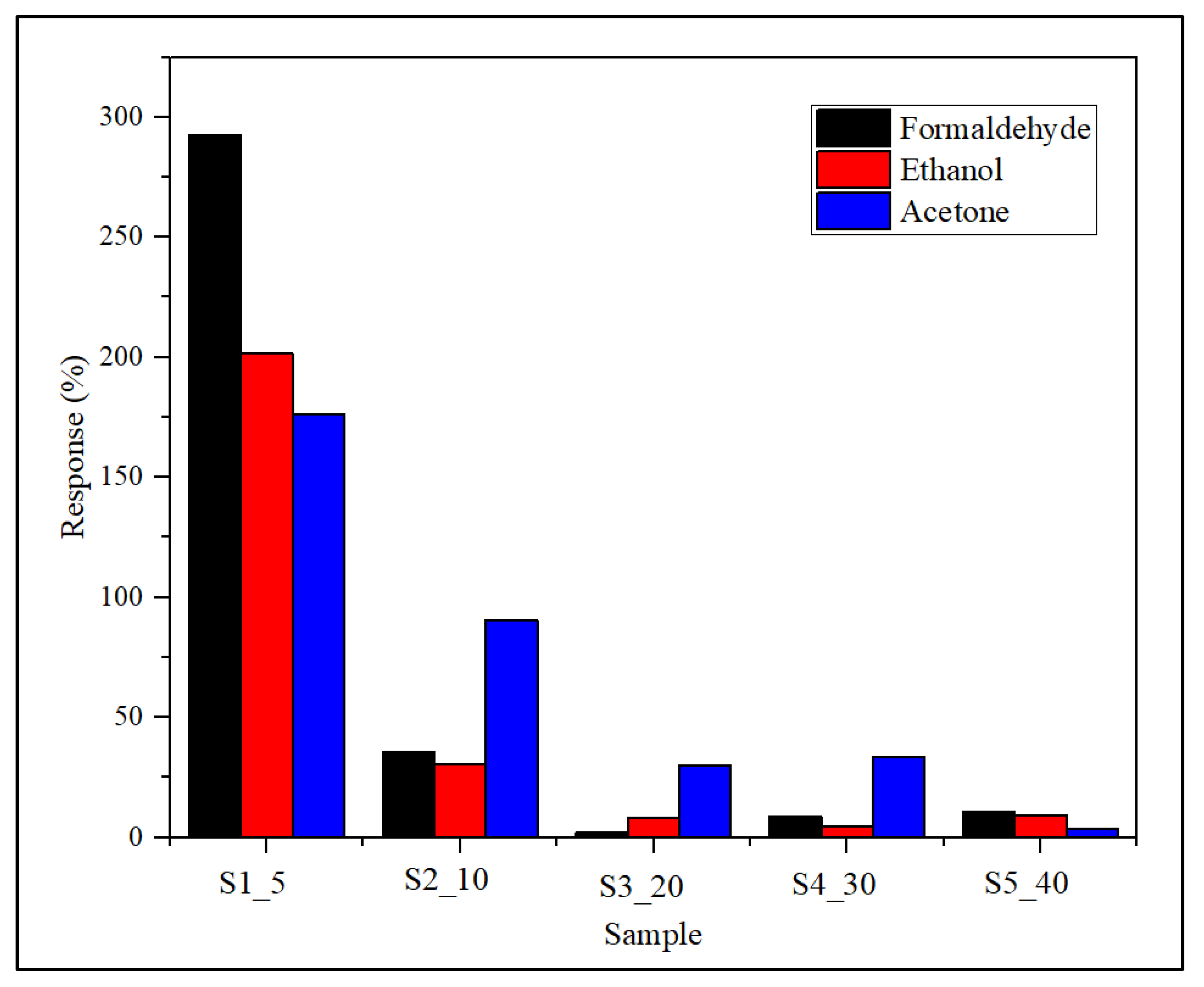
| Sample Name | Description |
|---|---|
| S1_5 | 5 wt%Fe3O4-PANI-90 wt%RGO |
| S2_10 | 10 wt%Fe3O4-PANI-80 wt%RGO |
| S3_20 | 20 wt%Fe3O4-PANI-60 wt%RGO |
| S4_30 | 30 wt%Fe3O4-PANI-40 wt%RGO |
| S5_40 | 40 wt%Fe3O4-PANI-20 wt%RGO |
Disclaimer/Publisher’s Note: The statements, opinions and data contained in all publications are solely those of the individual author(s) and contributor(s) and not of MDPI and/or the editor(s). MDPI and/or the editor(s) disclaim responsibility for any injury to people or property resulting from any ideas, methods, instructions or products referred to in the content. |
© 2023 by the authors. Licensee MDPI, Basel, Switzerland. This article is an open access article distributed under the terms and conditions of the Creative Commons Attribution (CC BY) license (https://creativecommons.org/licenses/by/4.0/).
Share and Cite
Abu Hussein, N.A.; Wong, Y.H.; Burhanudin, Z.A.; Hawari, H.F. Ternary Hybrid Materials for Highly Sensitive Acetone Sensing at Room Temperature. Crystals 2023, 13, 845. https://doi.org/10.3390/cryst13050845
Abu Hussein NA, Wong YH, Burhanudin ZA, Hawari HF. Ternary Hybrid Materials for Highly Sensitive Acetone Sensing at Room Temperature. Crystals. 2023; 13(5):845. https://doi.org/10.3390/cryst13050845
Chicago/Turabian StyleAbu Hussein, Nurul Athirah, Yew Hoong Wong, Zainal Arif Burhanudin, and Huzein Fahmi Hawari. 2023. "Ternary Hybrid Materials for Highly Sensitive Acetone Sensing at Room Temperature" Crystals 13, no. 5: 845. https://doi.org/10.3390/cryst13050845
APA StyleAbu Hussein, N. A., Wong, Y. H., Burhanudin, Z. A., & Hawari, H. F. (2023). Ternary Hybrid Materials for Highly Sensitive Acetone Sensing at Room Temperature. Crystals, 13(5), 845. https://doi.org/10.3390/cryst13050845







